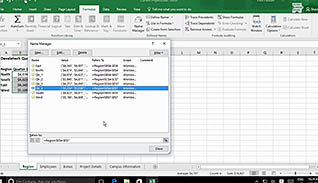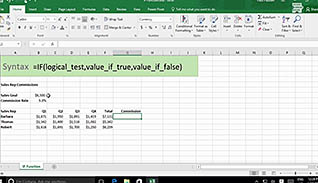Microsoft Excel 2016 Level 2.1: Working with Functions
- Product ID
- sonie16wf_vod
- Training Time ?
- 65 to 92 minutes
- Language(s)
- English
- Video Format
- High Definition
- Required Plugins
- None
- Number of Lessons
- 19
- Quiz Questions
- 27
- Closed Captioning
- Question Feedback
- Wrong Answer Remediation
- Lesson Bookmarking
- Downloadable Resources



Understanding the language of Excel enables users to increase the complexity of their data analysis. This course teaches how to use Microsoft Excel 2016 functions at a more advanced level.
As a foundation for using Excel functions, viewers are shown how to name and edit ranges, which allows users to navigate the workbook much faster. They learn how to use named ranges to create formulas. Using named ranges instead of cell ranges in formulas makes it easier to identify the data contained within the formula.
This course explains how working with logical functions and comparison operators lead to logical values, which establish whether criteria have been met. Viewers are shown how to use and apply different functions such as IF, AND, Text, and others, and are taught how to combine functions.
Watch this training course to learn how to do more with functions in Microsoft Excel 2016.
![]() This course is in the Video On Demand format, to read about Video On Demand features click here.
This course is in the Video On Demand format, to read about Video On Demand features click here.

- Install on any SCORM LMS
- Full-screen video presentation
- Print certificate and wallet card
- You have 30 days to complete the course
Everyone interested in learning more about Microsoft Excel 2016 functions
- Work with Functions
- Work with Ranges
- Name and Edit Ranges
- Use Defined Names in a Formula
- Locate and Use Specialized Functions
- Work with Logical Functions
- IF Function
- AND, OR and NOT Function
- Combine Functions
- Functions Similar to the IF Function
- Work with Date and Time Functions
- TODAY, NOW and DATE Functions
- NETWORKDAY, WEEKDAY, WORKDAY and ISOWeeknum Functions
- Work with Text Functions
- LEFT, RIGHT and MID Functions
- FIND Function
- Text to Columns Feature
- CONCATENATE Function
- UPPER, LOWER and PROPER Functions
-
Work with functions.
- Recall what you can find using the Tell me what you want to do search box tab.
- Distinguish between a relative and an absolute reference in a formula.
-
Work with ranges Excel 2016.
- Recall options for naming ranges in functions and formulas.
-
Name and edit ranges.
- Identify a shortcut for selecting cells.
- Recognize the different options for creating a name for a range of cells.
-
Use defined names in a formula.
- Recall how to replace cell references with range names.
-
Locate and use specialized functions.
- Recall proper formatting for criteria when creating a function manually.
-
Work with logical functions.
- Recall the values Excel returns when applying a logical test to data.
- Select examples of a logical function.
-
Work with IF functions.
- Recall the logical test performed by the IF function.
-
Work with AND, OR and NOT functions.
- Distinguish between the OR, AND, and NOT functions.
-
Combine multiple functions.
- Recall what is required of a function used as an argument.
- Recall what is required to create a nested or first level function.
-
Use functions similar to the IF function.
- Recall which statistical function counts the number of cells that meet specified criteria.
- Identify the required syntax elements when using functions like SUMIF and COUNTIF.
-
Work with date and time functions.
- Explain how Excel is able to display dates in a number of different formats.
-
Use the TODAY, NOW and DATE functions.
- Choose which function should be used to combine separate values to form a date.
-
Work with the NETWORKDAY, WEEKDAY, WORKDAY and ISOWEEKNUM functions.
- Recall which function returns a count of the number of workdays between two specific dates.
- Recall how to change the day of the week the WEEKDAY function begins counting.
-
Work with text functions
- Identify basic uses for Excel?s text functions.
-
Work with the LEFT, RIGHT and MID functions.
- Identify the equation(s) that will return the first 4 characters of text from a cell.
-
Use the FIND function.
- Recall criteria for using the FIND function.
-
Use the text to columns feature.
- Identify delimiters that can be used to split data into multiple columns when using the Text to Columns feature.
-
Join text strings using the CONCATENATE function.
- Identify which symbol can be used or to combine text from multiple cells the same way as the CONCATENATE function.
-
Work with the UPPER, LOWER and PROPER functions.
- Recall how many text arguments UPPER, LOWER and PROPER functions have.
© Mastery Technologies, Inc.



